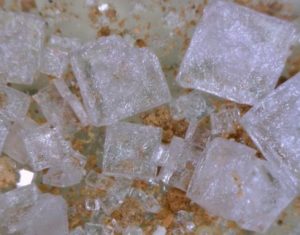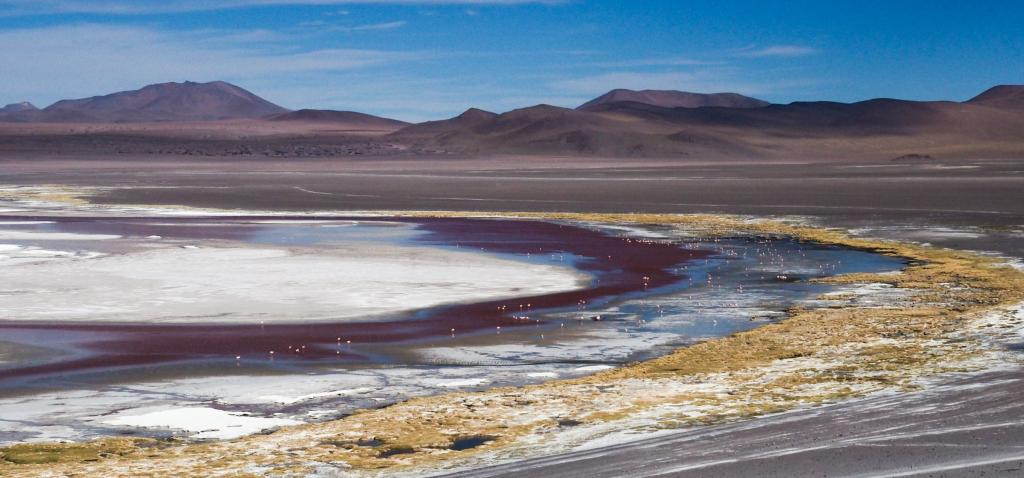2.5: Formation of Minerals
- Page ID
- 7742
\( \newcommand{\vecs}[1]{\overset { \scriptstyle \rightharpoonup} {\mathbf{#1}} } \)
\( \newcommand{\vecd}[1]{\overset{-\!-\!\rightharpoonup}{\vphantom{a}\smash {#1}}} \)
\( \newcommand{\dsum}{\displaystyle\sum\limits} \)
\( \newcommand{\dint}{\displaystyle\int\limits} \)
\( \newcommand{\dlim}{\displaystyle\lim\limits} \)
\( \newcommand{\id}{\mathrm{id}}\) \( \newcommand{\Span}{\mathrm{span}}\)
( \newcommand{\kernel}{\mathrm{null}\,}\) \( \newcommand{\range}{\mathrm{range}\,}\)
\( \newcommand{\RealPart}{\mathrm{Re}}\) \( \newcommand{\ImaginaryPart}{\mathrm{Im}}\)
\( \newcommand{\Argument}{\mathrm{Arg}}\) \( \newcommand{\norm}[1]{\| #1 \|}\)
\( \newcommand{\inner}[2]{\langle #1, #2 \rangle}\)
\( \newcommand{\Span}{\mathrm{span}}\)
\( \newcommand{\id}{\mathrm{id}}\)
\( \newcommand{\Span}{\mathrm{span}}\)
\( \newcommand{\kernel}{\mathrm{null}\,}\)
\( \newcommand{\range}{\mathrm{range}\,}\)
\( \newcommand{\RealPart}{\mathrm{Re}}\)
\( \newcommand{\ImaginaryPart}{\mathrm{Im}}\)
\( \newcommand{\Argument}{\mathrm{Arg}}\)
\( \newcommand{\norm}[1]{\| #1 \|}\)
\( \newcommand{\inner}[2]{\langle #1, #2 \rangle}\)
\( \newcommand{\Span}{\mathrm{span}}\) \( \newcommand{\AA}{\unicode[.8,0]{x212B}}\)
\( \newcommand{\vectorA}[1]{\vec{#1}} % arrow\)
\( \newcommand{\vectorAt}[1]{\vec{\text{#1}}} % arrow\)
\( \newcommand{\vectorB}[1]{\overset { \scriptstyle \rightharpoonup} {\mathbf{#1}} } \)
\( \newcommand{\vectorC}[1]{\textbf{#1}} \)
\( \newcommand{\vectorD}[1]{\overrightarrow{#1}} \)
\( \newcommand{\vectorDt}[1]{\overrightarrow{\text{#1}}} \)
\( \newcommand{\vectE}[1]{\overset{-\!-\!\rightharpoonup}{\vphantom{a}\smash{\mathbf {#1}}}} \)
\( \newcommand{\vecs}[1]{\overset { \scriptstyle \rightharpoonup} {\mathbf{#1}} } \)
\( \newcommand{\vecd}[1]{\overset{-\!-\!\rightharpoonup}{\vphantom{a}\smash {#1}}} \)
\(\newcommand{\avec}{\mathbf a}\) \(\newcommand{\bvec}{\mathbf b}\) \(\newcommand{\cvec}{\mathbf c}\) \(\newcommand{\dvec}{\mathbf d}\) \(\newcommand{\dtil}{\widetilde{\mathbf d}}\) \(\newcommand{\evec}{\mathbf e}\) \(\newcommand{\fvec}{\mathbf f}\) \(\newcommand{\nvec}{\mathbf n}\) \(\newcommand{\pvec}{\mathbf p}\) \(\newcommand{\qvec}{\mathbf q}\) \(\newcommand{\svec}{\mathbf s}\) \(\newcommand{\tvec}{\mathbf t}\) \(\newcommand{\uvec}{\mathbf u}\) \(\newcommand{\vvec}{\mathbf v}\) \(\newcommand{\wvec}{\mathbf w}\) \(\newcommand{\xvec}{\mathbf x}\) \(\newcommand{\yvec}{\mathbf y}\) \(\newcommand{\zvec}{\mathbf z}\) \(\newcommand{\rvec}{\mathbf r}\) \(\newcommand{\mvec}{\mathbf m}\) \(\newcommand{\zerovec}{\mathbf 0}\) \(\newcommand{\onevec}{\mathbf 1}\) \(\newcommand{\real}{\mathbb R}\) \(\newcommand{\twovec}[2]{\left[\begin{array}{r}#1 \\ #2 \end{array}\right]}\) \(\newcommand{\ctwovec}[2]{\left[\begin{array}{c}#1 \\ #2 \end{array}\right]}\) \(\newcommand{\threevec}[3]{\left[\begin{array}{r}#1 \\ #2 \\ #3 \end{array}\right]}\) \(\newcommand{\cthreevec}[3]{\left[\begin{array}{c}#1 \\ #2 \\ #3 \end{array}\right]}\) \(\newcommand{\fourvec}[4]{\left[\begin{array}{r}#1 \\ #2 \\ #3 \\ #4 \end{array}\right]}\) \(\newcommand{\cfourvec}[4]{\left[\begin{array}{c}#1 \\ #2 \\ #3 \\ #4 \end{array}\right]}\) \(\newcommand{\fivevec}[5]{\left[\begin{array}{r}#1 \\ #2 \\ #3 \\ #4 \\ #5 \\ \end{array}\right]}\) \(\newcommand{\cfivevec}[5]{\left[\begin{array}{c}#1 \\ #2 \\ #3 \\ #4 \\ #5 \\ \end{array}\right]}\) \(\newcommand{\mattwo}[4]{\left[\begin{array}{rr}#1 \amp #2 \\ #3 \amp #4 \\ \end{array}\right]}\) \(\newcommand{\laspan}[1]{\text{Span}\{#1\}}\) \(\newcommand{\bcal}{\cal B}\) \(\newcommand{\ccal}{\cal C}\) \(\newcommand{\scal}{\cal S}\) \(\newcommand{\wcal}{\cal W}\) \(\newcommand{\ecal}{\cal E}\) \(\newcommand{\coords}[2]{\left\{#1\right\}_{#2}}\) \(\newcommand{\gray}[1]{\color{gray}{#1}}\) \(\newcommand{\lgray}[1]{\color{lightgray}{#1}}\) \(\newcommand{\rank}{\operatorname{rank}}\) \(\newcommand{\row}{\text{Row}}\) \(\newcommand{\col}{\text{Col}}\) \(\renewcommand{\row}{\text{Row}}\) \(\newcommand{\nul}{\text{Nul}}\) \(\newcommand{\var}{\text{Var}}\) \(\newcommand{\corr}{\text{corr}}\) \(\newcommand{\len}[1]{\left|#1\right|}\) \(\newcommand{\bbar}{\overline{\bvec}}\) \(\newcommand{\bhat}{\widehat{\bvec}}\) \(\newcommand{\bperp}{\bvec^\perp}\) \(\newcommand{\xhat}{\widehat{\xvec}}\) \(\newcommand{\vhat}{\widehat{\vvec}}\) \(\newcommand{\uhat}{\widehat{\uvec}}\) \(\newcommand{\what}{\widehat{\wvec}}\) \(\newcommand{\Sighat}{\widehat{\Sigma}}\) \(\newcommand{\lt}{<}\) \(\newcommand{\gt}{>}\) \(\newcommand{\amp}{&}\) \(\definecolor{fillinmathshade}{gray}{0.9}\)In order for a mineral crystal to grow, the elements needed to make it must be present in the appropriate proportions, the physical and chemical conditions must be favourable, and there must be sufficient time for the atoms to become arranged.
Physical and chemical conditions include factors such as temperature, pressure, presence of water, pH, and amount of oxygen available. Time is one of the most important factors because it takes time for atoms to become ordered. If time is limited, the mineral grains will remain very small. The presence of water enhances the mobility of ions and can lead to the formation of larger crystals over shorter time periods.
Most of the minerals that make up tehe rocks around us formed through the cooling of molten rock, known as magma. At the high temperatures that exist deep within Earth, some geological materials are liquid. As magma rises up through the crust, either by volcanic eruption or by more gradual processes, it cools and minerals crystallize. If the cooling process is rapid (minutes, hours, days, or years), the components of the minerals will not have time to become ordered and only small crystals can form before the rock becomes solid. The resulting rock will be fine-grained (i.e., with crystals less than 1 mm). If the cooling is slow (from decades to millions of years), the degree of ordering will be higher and relatively large crystals will form. In some cases, the cooling will be so fast (seconds) that the texture will be glassy, which means that no crystals at all form. Volcanic glass is not composed of minerals because the magma has cooled too rapidly for crystals to grow, although over time (millions of years) the volcanic glass may crystallize into various silicate minerals.
Minerals can also form in several other ways:
- Precipitation from aqueous solution (i.e., from hot water flowing underground, from evaporation of a lake or inland sea, or in some cases, directly from seawater) (see Exercise 2.7 below),
- Precipitation from gaseous emanations,
- Metamorphism: formation of new minerals directly from the elements within existing minerals under conditions of elevated temperature and pressure,
- Weathering: during which minerals unstable at Earth’s surface may be altered to other minerals,
- Organic formation: formation of minerals within shells (primarily calcite) and teeth and bones (primarily apatite) by organisms (these organically formed minerals are still called minerals because they can also form inorganically).
Opal is a mineraloid (i.e., not an actual mineral) because although it has all of the other properties of a mineral, it does not have a specific structure. Pearl is not a mineral because it can only be produced by organic processes.

Place about ½ teaspoon (~2.5 cm3) of any kind of table salt into a small bowl. Add about 2 teaspoons (~10 mL) of very hot water and swirl it around for a few minutes until all or almost all of the salt has dissolved. (Be careful not to splash yourself with the hot water.)
Place the bowl in a safe place (windowsill, bookshelf), and check back every 24 hours to see what has happened. Depending on the level of humidity in the room, you should see crystals forming within 24 hours, and all of the water should be gone, with reasonably large crystals formed, within about 3 days. They should look a little like those shown here. In other words, they should be cubes.
Now try the same experiment again, but this time put the salt and water into a small sauce pan on the stove top at the lowest heat possible. Within 10 to 20 minutes all of the water should be gone and you should be left with some very small salt crystals—too small to even see their shapes. It takes time for mineral crystals to form.
Where does lithium come from?
The global demand for lithium has increased dramatically in the past decade, and will increase even more in the future as long as there is increasing demand for lithium-ion batteries in electronic devices, electric vehicles and for storage of solar- and wind-generated energy. Most of the world’s lithium supply comes from salt lakes (salars in Spanish) like the one shown below in southwestern Bolivia.

Media Attributions
- Figure \(\PageIndex{1}\): © Steven Earle. CC BY.
- Figure \(\PageIndex{2}\): © Isaac Earle. CC BY.


